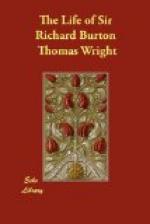By her will dated, 28th December 1895, she left some (pounds)12,000 to her sister, Mrs. FitzGerald,[FN#695] and the following persons also benefitted: her sister, Mrs. Van Zeller, (pounds)500; her secretary, Miss Plowman (pounds)25; Khamoor (pounds)50; her nephew Gerald Arthur Arundell, the cottage at Mortlake; the Orphanage at Trieste, (pounds)105. She directed that after her heart had been pierced with a needle her body was to be embalmed in order that it might be kept above ground by the side of her husband. She stated that she had bought a vault close to the tent, and that two places were to be reserved in it in order that if a revolution should occur in England, and there should be fear of the desecration of the dead, the coffins of her husband and herself might be lowered into it. She provided for 3,000 masses to be said for her at once at Paris, and left an annuity to pay for a daily mass to be said there perpetually. The attendance of priests at her funeral was to be “as large as possible.”
Lady Burton was buried on Friday March 27th, the service taking place in the Catholic church at Mortlake where five years previous she had knelt beside the coffin of her husband; and a large number of mourners was present. After mass her remains were carried to the Arab Tent, and so she obtained her wish, namely, that in death she and her husband might rest in the same tomb.
185. Miss Stisted’s “True Life.”
As might have been expected, Lady Burton’s Life of her husband gave umbrage to the Stisted family—and principally for two reasons; first its attempt to throw a flood of Catholic colour on Sir Richard, and secondly because it contained statements which they held to be incorrect. So after Lady Burton’s death, Miss Stisted wrote and published a small work entitled The True Life of Sir Richard Burton. It is written with some acerbity, for Lady Burton as a Catholic was not more militant than Miss Stisted as a Protestant. It throws additional and welcome light on Sir Richard’s early days, but as we have elsewhere remarked, the principal charge that it made against Lady Burton, namely that she was the main cause of her husband’s downfall at Damascus, is unsupported by sufficient evidence.
186. Mr. Wilkins’s Work, 1897.
That there should be a counterblast to The True Life was inevitable, and it came in the shape of The Romance of Isabel Lady Burton, which consists of Lady Burton’s unfinished autobiography and a continuation by Mr. W. H. Wilkins. The work is a valuable addition to Burton lore, but Mr. Wilkins’s friendship for Lady Burton led him to place her on a far higher pedestal than we have been able to give her. Perhaps it was natural that in dealing with the True Life he should have betrayed some heat. However, death has now visited Miss Stisted[FN#696] as well as Lady Burton, and the commotion made by the falling of the stone into the pool is at this distance represented only by the faintest of circles. In 1898, Mr. Wilkins published, with an acceptable preface, three of Burton’s unfinished works in one volume, with the title of The Jew, the Gypsy, and El Islam, and in 1901 he placed the public under further obligation to him by editing and issuing Burton’s Wanderings in Three Continents.




